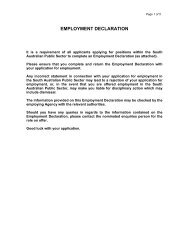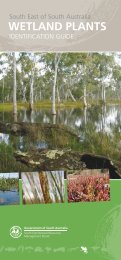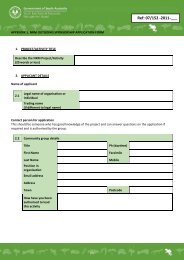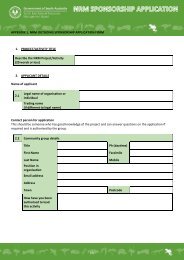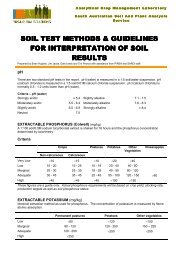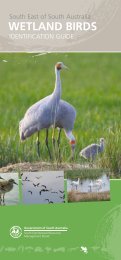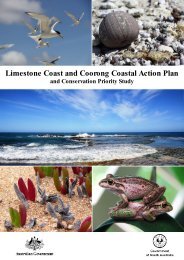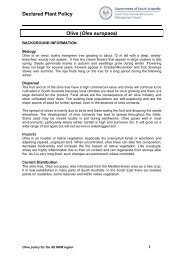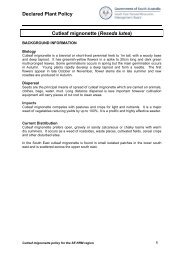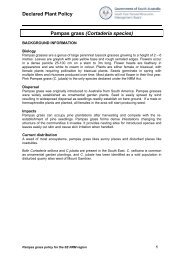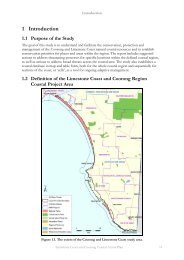Cell Descriptions - South East Natural Resources Management Board
Cell Descriptions - South East Natural Resources Management Board
Cell Descriptions - South East Natural Resources Management Board
You also want an ePaper? Increase the reach of your titles
YUMPU automatically turns print PDFs into web optimized ePapers that Google loves.
SE14 – Long Beach<br />
held as a miscellaneous Crown lease. No vegetated areas are protected by heritage agreement or<br />
park status. Upper <strong>South</strong> <strong>East</strong> Marine Park extends the length of the cell.<br />
Values/ Uses (Field visits and local reports)<br />
Much of this area is zoned for grazing; with smaller areas of farming and rural residential land in<br />
the south of the cell. Long Beach is used for shore based fishing.<br />
Threats (Field visits and local reports)<br />
ORV tracks are heavy throughout the remnant dunes. Combined with pest plant and animal<br />
threats, the remnant coastal shrubland is degraded and almost non-existent in places. Spiny Rush<br />
(Juncus acutus) is common around the coastal wetlands including Lake Nadzab and the low lying<br />
agricultural land and along road reserves. Discharge of nutrient rich and sediment laden waters<br />
from Blackford Drain is impacting upon nearshore seagrass meadows.<br />
Opportunities<br />
Encourage landholders to exclude ORVs and grazing from coastal dunes and assist landholders<br />
with pest plant and animal control to improve the quality of remnant shrub- and grass-land<br />
communities. Possible opportunity for an investigation into the effects of sea-wheat grass on<br />
beach morphology and fauna impacts. Dune drift and blowouts in the vegetated dunes north of<br />
Blackford Drain could be rehabilitated. Opportunities to redirect flows from Blackford Drain or<br />
polish water via wetlands should be explored.<br />
Conservation Analysis (GIS)<br />
The total of conservation mean values, 73.77 is the lowest in the region. The detailed summary<br />
map is remarkable in that no part of the cell shows a total higher than medium low, and almost<br />
all is low. Habitat for butterflies and for numbers of threatened mammals within the uncleared<br />
dunes, and viewscape in the foredune area show high means. However, it is notable that total<br />
means for layers relating to threatened plant species, for birds and reptile habitat, as well as<br />
Indigenous and European heritage, are extremely low.<br />
Threat Analysis (GIS)<br />
Total for threat summary means is high, 66.09. ORV activity, land ownership, viewscape, land<br />
use, vegetation block degradation, numbers of significant weeds (throughout the cell), dune<br />
instability (a potential threat through much of the cell), numbers of rabbits are high throughout,<br />
are the major contributors to this high total. Dune habitat in the southern half of the cell, noted<br />
in the previous paragraph, is threatened by vegetation block isolation, adjacency of the dump, as<br />
well as ORV activity. Petroleum extraction licences are current for the area south of Blackford<br />
Drain. Existing residential development (and rural residential zoning) poses threats in the south.<br />
Adaptation to Climate Change: Threats for cell SE14<br />
(see also discussion of scenario in Section 4.11<br />
NOTE: the advice below is indicative of likely change and the direction of change, with<br />
implications for ecosystems. Dates, amounts and probabilities cannot be accurately calculated at<br />
this time. Thus advice on flood levels, for example, should not be used in engineering or<br />
development planning.<br />
Limestone Coast and Coorong Coastal Action Plan 444



